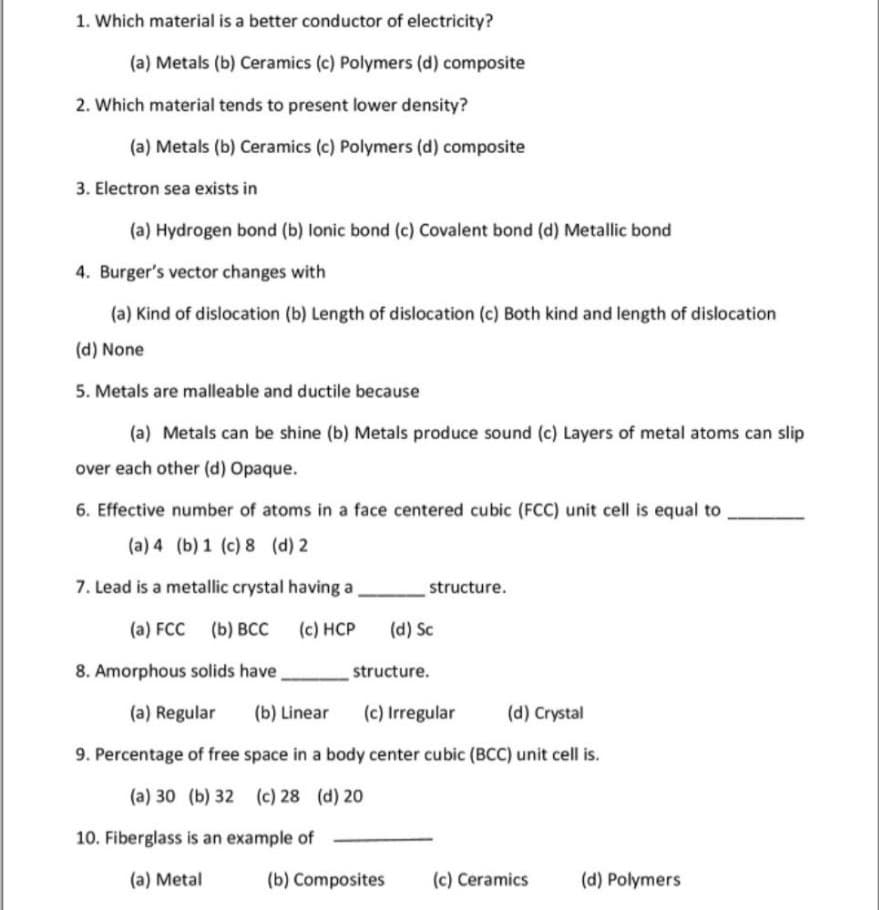1. Which material is a better conductor of electricity? (a) Metals (b) Ceramics (c) Polymers (d) composite 2. Which material tends to present lower density? (a) Metals (b) Ceramics (c) Polymers (d) composite 3. Electron sea exists in (a) Hydrogen bond (b) lonic bond (c) Covalent bond (d) Metallic bond 4. Burger's vector changes with (a) Kind of dislocation (b) Length of dislocation (c) Both kind and length of dislocation (d) None 5. Metals are malleable and ductile because (a) Metals can be shine (b) Metals produce sound (c) Layers of metal atoms can slip over each other (d) Opaque. 6. Effective number of atoms in a face centered cubic (FCC) unit cell is equal to (a) 4 (b) 1 (c) 8 (d) 2 7. Lead is a metallic crystal having a structure. (a) FCC (b) BCC (c) HCP (d) Sc 8. Amorphous solids have structure. (a) Regular (b) Linear (c) Irregular (d) Crystal 9. Percentage of free space in a body center cubic (BCC) unit cell is. (a) 30 (b) 32 (c) 28 (d) 20 10. Fiberglass is an example of (a) Metal (b) Composites (c) Ceramics (d) Polymers
1. Which material is a better conductor of electricity? (a) Metals (b) Ceramics (c) Polymers (d) composite 2. Which material tends to present lower density? (a) Metals (b) Ceramics (c) Polymers (d) composite 3. Electron sea exists in (a) Hydrogen bond (b) lonic bond (c) Covalent bond (d) Metallic bond 4. Burger's vector changes with (a) Kind of dislocation (b) Length of dislocation (c) Both kind and length of dislocation (d) None 5. Metals are malleable and ductile because (a) Metals can be shine (b) Metals produce sound (c) Layers of metal atoms can slip over each other (d) Opaque. 6. Effective number of atoms in a face centered cubic (FCC) unit cell is equal to (a) 4 (b) 1 (c) 8 (d) 2 7. Lead is a metallic crystal having a structure. (a) FCC (b) BCC (c) HCP (d) Sc 8. Amorphous solids have structure. (a) Regular (b) Linear (c) Irregular (d) Crystal 9. Percentage of free space in a body center cubic (BCC) unit cell is. (a) 30 (b) 32 (c) 28 (d) 20 10. Fiberglass is an example of (a) Metal (b) Composites (c) Ceramics (d) Polymers
Principles of Heat Transfer (Activate Learning with these NEW titles from Engineering!)
8th Edition
ISBN:9781305387102
Author:Kreith, Frank; Manglik, Raj M.
Publisher:Kreith, Frank; Manglik, Raj M.
Chapter4: Numerical Analysis Of Heat Conduction
Section: Chapter Questions
Problem 4.52P
Related questions
Question

Transcribed Image Text:1. Which material is a better conductor of electricity?
(a) Metals (b) Ceramics (c) Polymers (d) composite
2. Which material tends to present lower density?
(a) Metals (b) Ceramics (c) Polymers (d) composite
3. Electron sea exists in
(a) Hydrogen bond (b) lonic bond (c) Covalent bond (d) Metallic bond
4. Burger's vector changes with
(a) Kind of dislocation (b) Length of dislocation (c) Both kind and length of dislocation
(d) None
5. Metals are malleable and ductile because
(a) Metals can be shine (b) Metals produce sound (c) Layers of metal atoms can slip
over each other (d) Opaque.
6. Effective number of atoms in a face centered cubic (FCC) unit cell is equal to
(a) 4 (b) 1 (c) 8 (d) 2
7. Lead is a metallic crystal having a
structure.
(a) FCC
(b) ВСС
(c) HCP
(d) Sc
8. Amorphous solids have
structure.
(a) Regular
(b) Linear
(c) Irregular
(d) Crystal
9. Percentage of free space in a body center cubic (BCC) unit cell is.
(a) 30 (b) 32 (c) 28 (d) 20
10. Fiberglass is an example of
(a) Metal
(b) Composites
(c) Ceramics
(d) Polymers
Expert Solution
This question has been solved!
Explore an expertly crafted, step-by-step solution for a thorough understanding of key concepts.
This is a popular solution!
Trending now
This is a popular solution!
Step by step
Solved in 2 steps with 2 images

Recommended textbooks for you

Principles of Heat Transfer (Activate Learning wi…
Mechanical Engineering
ISBN:
9781305387102
Author:
Kreith, Frank; Manglik, Raj M.
Publisher:
Cengage Learning

International Edition---engineering Mechanics: St…
Mechanical Engineering
ISBN:
9781305501607
Author:
Andrew Pytel And Jaan Kiusalaas
Publisher:
CENGAGE L

Principles of Heat Transfer (Activate Learning wi…
Mechanical Engineering
ISBN:
9781305387102
Author:
Kreith, Frank; Manglik, Raj M.
Publisher:
Cengage Learning

International Edition---engineering Mechanics: St…
Mechanical Engineering
ISBN:
9781305501607
Author:
Andrew Pytel And Jaan Kiusalaas
Publisher:
CENGAGE L